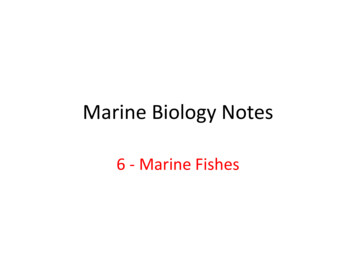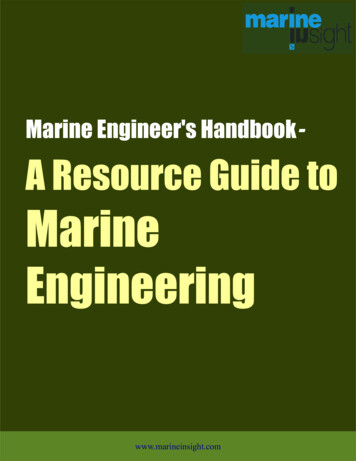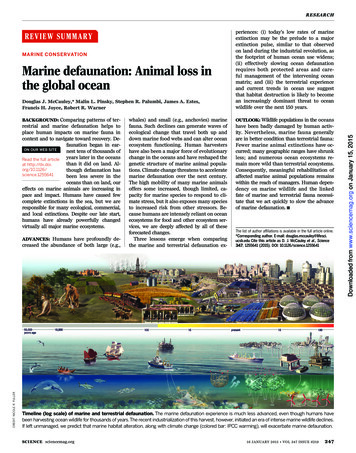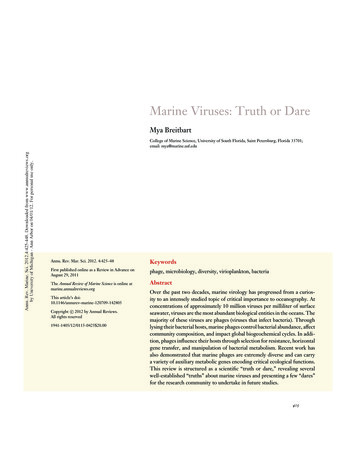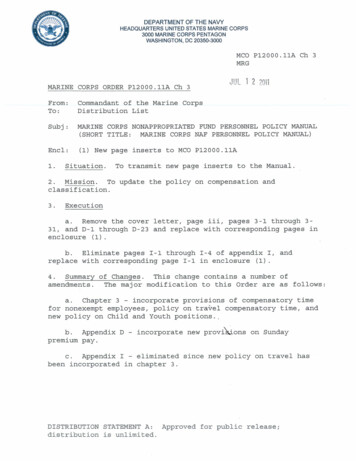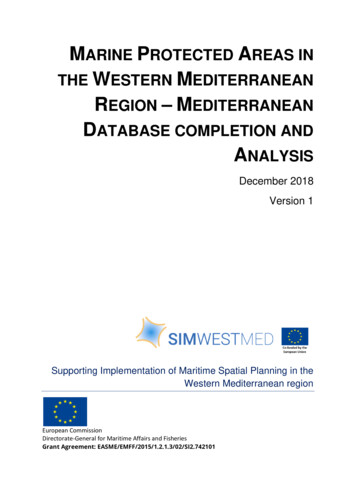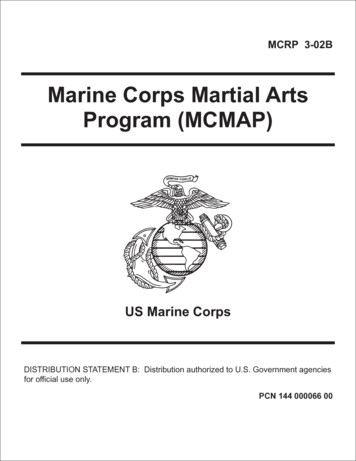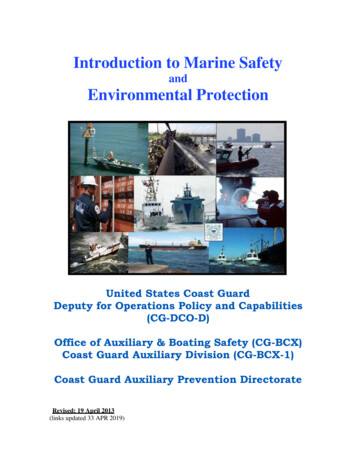
Transcription
Introduction to Marine SafetyandEnvironmental ProtectionUnited States Coast GuardDeputy for Operations Policy and Capabilities(CG-DCO-D)Office of Auxiliary & Boating Safety (CG-BCX)Coast Guard Auxiliary Division (CG-BCX-1)Coast Guard Auxiliary Prevention DirectorateRevised: 19 April 2013(links updated 33 APR 2019)
IMSEP-2-
Introduction to Marine Safety and Environmental Protection(Prevention)(modified 04/19/13)Table of Contents1.02.03.0Introduction and Learning Objectives1.1Introduction1.2Learning Objectives1.3Review Questions and End of Course ExamMarine Safety2.1Coast Guard Missions and Structure2.2The Importance of Marine Safety Regulations and Enforcement2.3The Marine Safety Program2.4Marine Safety Manual (MSM)2.5The Marine Inspection (MI) Program2.6Port Safety and Security (PSS) Program2.7PSS Program Evaluation and ManagementAuxiliary Support for Coast Guard Marine Safety (Prevention) Programs3.1Maritime Observation Mission (MOM)3.2Container Inspection Support3.3Support for Ferry and Small Passenger Vessel Inspections3.4Examination of Commercial Towing Vessels (UTV) and UninspectedPassenger Vessels (UPV)3.5America’s Waterway WatchIMSEP3
4.05.03.6Support for Regional Exam Centers and field visits to maritimetraining schools3.7Commercial Fishing Vessel Examinations (CFVEs) and“Dockwalkers” public affairs support3.8Development of training and qualifications standards and materialsfor Auxiliary members participating in marine safety programs andactivities3.9Facility Inspections3.10Domestic & Port State Inspections3.11Investigations3.12Auxiliary Performance Qualification Standards (PQS) insupport of Marine Safety ProgramsThe Marine Environmental Protection (MEP) Program4.1History4.2Program Activities4.3Pollution Response Activities4.4Response Oversight4.5International Conventions4.6Coast Guard In-House Compliance with Environmental Law4.7Marine Pollution Financial Responsibility and CompensationActivityAuxiliary Support for Coast Guard Marine Environmental Protection andResponse Programs5.1“Sea Partners” and “Officer Snook” Education & Public OutreachProgram5.2Aquatic Nuisance Species (ANS) MitigationIMSEP4
6.07.08.05.3The Good Mate Program5.4National Clean Boating Campaign/Clean Vessel Act Support5.5Clean Marina Program Support5.6National Marine Debris Monitoring and Beach Cleanup Programs5.7Marine Mammal Monitoring5.8HAZMAT/HAZWOPER Education and Patrol Support5.9Auxiliary Assistant Pollution Responder (AUX-ED)Marine Transportation Systems (CG-5PW)(formerly Office of Waterways Management (CG-55)6.1Program Objectives6.2ProgramsAuxiliary Support for Coast Guard Marine Transportation Systems7.1Maritime Observation Mission (MOM)7.2Identification of Abandoned Vessels and Barges7.3Local Harbor Safety Committees7.4Support for the National Oceanic and Atmospheric Administration(NOAA) and the United States Army Corps of Engineers (USACE)with Chart Updating7.5Auxiliary Bridge Administration Program7.6ATONs and PATONSRecreational Boating Safety Program8.1Mission8.2History and Today8.3Boat ResponsiblyIMSEP5
9.010.011.012.0Planning and Emergency Management9.1Training and Familiarization with the Incident Command System(ICS) and Auxiliary requirements9.2Guidelines for Emergency Response9.3Auxiliary Support to the Coast Guard for Local and Area Planning9.4Cooperation and Team-Building with Local Emergency ResponseOrganizations9.5The Development of Field Training Exercises and Drills to EvaluateEmergency PreparednessControl and Enforcement Actions10.1Flag State and Port State Responsibilities10.2Vessel Categories10.3Inspection Types10.4Merchant Mariner Licensing10.5Marine Investigations10.6Sources of Authority10.7Control and Enforcement Action10.8Intervention and International AgreementsFederal Laws and Regulations11.1Definitions11.2Legal and Regulatory Publications11.3Coast Guard GuidanceOccupational Safety and Health12.1Framework12.2Command Organization and ResponsibilitiesIMSEP6
13.012.3Occupational Medical Surveillance and Evaluation Program(OMSEP)12.4Marine Safety Field Hazards12.5Evaluating and Controlling Field Hazards12.6Confined Space SafetyConduct and Ethics13.1Standards of Ethical Conduct13.2ProfessionalismReview QuestionsAppendixWeb Links to:U.S. Coast GuardU.S. S. IndianapolisThe SultanaAnswers to Review QuestionsIMSEP7
Introduction to Marine Safety and Environmental Protection1.0Introduction and Learning Objectives1.1IntroductionThis course is designed to introduce members of Team Coast Guard – ActiveDuty, Reserve, Auxiliary and Civil Service – to the marine safety organization,history, missions, functions and programs of the United States Coast Guard. Thecourse is intended primarily for non-resident training purposes. Taking advantageof its web-based information, each course component may be detached andupdated independently. This insures that the course can be continuously updatedas programs and organizations change and evolve over time.Trainees and members will be required to have access to the internet to retrievethe numerous web documents referenced. The Introduction to Marine Safety andEnvironmental Protection end of course exam has questions from this documentand many of these web resources.Coast Guard web pages on the Marine Safety Program:The US Coast Guard HistorianThe Auxiliary Prevention DepartmentThe Code of Federal Regulations (CFR)The United States Code (USC)Marine Safety Manuals (MSM)1.2Learning ObjectivesCompletion of this course will accomplish the following objectives. Acquaint the trainee with the history and organization of the MarineSafety and Environmental Protection functions of the Coast Guard.Provide the trainee an overview of the organization and content of CoastGuard Marine Safety and Environmental Protection programs.Provide the trainee a basic working knowledge of the Marine SafetyManual and the Code of Federal Regulations.Provide a basic educational component for members working towardqualifications in Marine Safety and Environmental Protection and a firststep in meeting the qualifications for the Marine Safety TrainingRibbon and the Marine Safety Insignia.Satisfy member basic education requirements in Marine Safety andEnvironmental Protection and provide for member recognition andcontinuing education credit.IMSEP8
1.3Review Questions and End of Course ExamIt is recommended that each student read and answer the review questions inorder to be familiar with the substance as well as the format of questions that willappear on the End of Course Exam. There are questions taken directly from thisdocument and questions that will require access to web pages referenced in thetext. Students should not attempt the End of Course Exam unless they are able topass the review questions with a score of 90%. Answers to the review questionswill be found in the Appendix.IMSEP9
2.0Marine Safety2.12.1.1Coast Guard Missions and StructureCoast Guard MissionsThe U.S. Coast Guard is the principal federal agency charged with MaritimeSafety, Maritime Security and Maritime Mobility. Additional Coast Guardmissions include National Defense and Protection of our Natural Resources.There are numerous Missions as shown below, assigned to the Coast Guard. Thiscourse will concentrate on two, Maritime Safety and Protection of NaturalResources.Many of these mission-programs benefit more than one role, but each directlysupports the roles of safety, security and stewardship.ProgramMissionMarine SafetyMaritime SafetySaving Lives and ProtectingPropertySearch and RescueRecreational Boater SafetyPassenger Vessel SafetyInternational Ice PatrolPort SecurityMaritime SecurityIllegal Drug InterdictionAlien Migrant InterdictionEstablishing and Maintaining aSecure Maritime System whileFacilitating its use for theNational GoodEEZ & Living Marine ResourceGeneral Maritime LawLaw/Treaty EnforcementIMSEP10
Maritime MobilityAids to NavigationIcebreaking ServicesVessel Traffic ServicesBridge AdministrationRules of the RoadNational DefenseGeneral Defense DutiesMaritime Intercept OperationsDeployed Port Operations and SecurityPeacetime EngagementEnvironmental Defense OperationsProtection of NaturalResourcesManaging the Sustainable &Effective use of its Inland,Coastal and Ocean Waters &Resources for the FutureMarine and Environmental ScienceLiving Marine Resources ProtectionForeign Vessel InspectionsMarine Pollution Education, Prevention,Response, and EnforcementMarine Environmental ProtectionIMSEP11
2.1.2Coast Guard StructureA. SectorsIn 2006, by the authority of the Commandant, the Coast Guard reorganized allfield units including Marine Safety Offices, Groups, Vessel Traffic Services(VTSs), and, in some cases, Air Stations, into Sector Commands having largelyor entirely the same Areas of Responsibility (AOR). Sector Commanders arevested with all the rights, responsibilities, duties, and authority of a GroupCommander and a Commanding Officer, Marine Safety Office (MSO), asprovided for in United States Coast Guard Regulations 1992, COMDTINSTM5000.3 (series).B. Sector Commanders carry out the Sector’s missions as follows:1. Captain of the Port (COTP) COMDTINST M5401.6 1-22. Federal Maritime Security Coordinator (FMSC) when serving as COTPfor an Area Maritime Security (AMS) area pursuant to 33 CFR§103.2003. Federal On-Scene Coordinator (FOSC) consistent with the NationalContingency Plan4. Officer in Charge, Marine Inspection (OCMI)5. Search and Rescue (SAR) Mission Coordinator (SMC)C. Unified CommandThe tragic events of September 11, 2001, substantially altered recognition ofsecurity risks to marine transportation similar to changes in environmental riskthat were recognized as the result of major pollution incidents. This reinforced theimportance of collaborative preparedness for incident management and the needfor a unified command construct that:1. improves mission planning execution and performance outcomes,2. increases interaction and coordination between operational commandsand interagency partners,3. manages and helps develop the Common Operational Picture (COP),4. brings new focus to the value of planning and sustainment ofoperational readiness, and5. shares information and intelligence more rapidly than before.Sectors are structured along process lines to manage the full range of operationalprevention and response activities. The decision to develop Sectors was anextension of previous actions to consolidate field units over the years and was alogical next step to formalize the successes and best practices that have beenoperational in the field. Sectors adopted the successful model that was groundIMSEP12
tested in New York City and Baltimore on September 11th.D. Sector MissionsThe mission of each Coast Guard Sector is to accomplish assigned Coast Guardmissions, functions, and responsibilities. Sector mission objectives include:1. provision of unified command and control for the integrated conduct ofoperations,2. coordinated leveraging of maritime partner relationships,3. foresight in planning, and4. aggressive risk-based employment of assets and capabilities within theassigned AOR.E. Preparedness ContinuumThe move to Sectors represents a transformation from a Coast Guard traditionallyorganized around its operational programs, to one that is organized around thepreparedness continuum of prevention, protection, response and recovery withprogrammatic and functional areas of responsibility embedded as sub-elements.The organization construct relies on integrated coordination of all assignedoperational capabilities to optimize utilization of Coast Guard resources inaccomplishing assigned agency missions, functions and responsibilities. Itrecognizes that, in a broad sense, all Coast Guard operational activities are eitherfocused on prevention of an incident or illegal event, or in response to mitigatethe undesired effects of an incident. The command and control processes used toexecute those two operational mission areas are interrelated as follows:1. PreventionFocuses largely on gaining compliance with regulatory standardsand the design and maintenance of waterway systems to prevent incidents.Prevention functions include:(a) inspections/examinations of vessels and waterfront facilities toensure compliance with federal safety, security, andenvironmental regulations,(b) investigations of marine casualties to determine the cause ofaccidents, pursuing Maritime Personnel Actions/CivilPenalties, and to serve as a feedback loop into complianceinspections and regulatory development,(c) develop and maintain the waterway navigation infrastructure(i.e. Aids to Navigation (ATON)), and(d) manage traffic through Vessel Traffic System (VTS) centersand the use of Captain of the Port Order, Limited Access Areas,IMSEP13
and Regulated Navigation Areas.2. ResponseFocuses on command and control activities associated with an emergencyincident response and/or heightened threat situation that requires swiftenforcement actions. Response requires proficiency in high tempocommand, control and communications processes, and the exercise ofresponse and security enforcement expertise to accomplish incidentcommand and crisis management. Response functions include:(a) search and rescue (SAR),(b) marine environmental protection; responding to oil spills tomonitor and supervise cleanup operations,(c) incident management, and(d) law enforcement.3. LogisticsProvides the capabilities to support Sector operational missions andprevention activities through the coordinated balance between assetmaintenance, personnel management, medical readiness, foodpreparations, and financial aspects of planned and unscheduled operations.Logistics functions include:(a) administration & personnel management of Sector Staff andsubordinate commands,(b) responsibility for Naval and Facilities Engineering (publicworks) programs for Sector and subordinate commands,(c) financial management of Sector budget and disbursement tosubordinate commands,(d) responsibility for medical clinic if assigned, and(e) responsibility for unit Sector and AOR tenantinternal environmental compliance requirements.F. Sector Command Center.The Sector Command Center (SCC) serves an operations integration function.Each SCC is located organizationally to support Response and Preventionoperations. For example, the SCC supports the Response Department during asearch and rescue response and likewise, supports the Prevention Departmentduring a marine event.G. Sector Field Offices (SFOs).The creation of Sectors transformed a diverse array of field offices/units into aIMSEP14
standard Sector Command organizational architecture, consisting of Prevention,Response, and Logistics components as described above.Command and control is centralized to serve all three components including fieldunits. This resulted in the conversion of some outlying Groups (which were notdirectly absorbed in the creation of the Sector command cadre) to SFOs. All fieldlevel units/offices report directly to the Sector and its components. SFOs areextensions of the Sector staff, and do not constitute another layer of command.Their purpose is to provide support to outlying units in locations where distanceand workload render it necessary to have remote offices serving various supportroles in specific areas.H. Marine Safety Units (MSUs).As with SFOs, some outlying Marine Safety Offices (MSOs) during theconversion retained their functions and command status but were renamed MSUs.Marine Safety Units specialize in port security, marine inspections, environmentalresponse, maritime investigations, and waterways management. Some MSUs stillretain OCMI, COTP and FOSC authority over a designated portion of the Sector'sArea of Responsibility (AOR).I. Marine Safety Detachments (MSDs).Marine Safety Offices, which did not retain command as MSUs or weregeographically distant from the newly created Sectors were converted to MSDsand specialize in many of the same missions as MSUs. Active Duty and Reservepersonnel attached to a MSD are under the operational control (OPCON) of thePrevention Department. Assigned personnel perform marine safety duties andremain under the administrative control (ADCON) of the parent Sector.J. Sector Organization Charts.1. Figures 1.G.1. through 1.G.3. indicate a Sector’s location within theCoast Guard organization and a detailed departmental chart for all CoastGuard Sectors.2. Organizational Flexibility: Like ports, no two Sectors are exactly alike.A host of discriminators directly impact how a Sector Commander leadsand manages his or her command. Span of control, varying operationaltempo, mission mix and complexity, geography, industry types,international concerns, federal, state and local government agencies,interagency and industry relationships, legacy asset/staffing levels, andinter and intra-service relationships all affect workload and staffing.IMSEP15
Figure 1.G.1. Coast Guard Sector Chain of CommandIMSEP16
Figure 1.G.2. Standard Coast Guard Sector OrganizationIMSEP17
Figure 1.G.3. Detailed Coast Guard Sector OrganizationIMSEP18
2.2The Importance of Marine Safety Regulations and EnforcementThe greatest loss of life in a marine accident involving U.S. citizens was not thesinking of the RMS Titanic after it hit an iceberg in 1912. It was not the sinkingof the RMS Luisitania by a German U-Boat in 1915 before the U.S. entered theFirst World War, nor was it the sinking of the U.S.S Indianapolis by a Japanesesubmarine in 1945 after it delivered the atomic bomb named Little Boy that waslater dropped on Hiroshima.The greatest loss of life in US maritime history occurred in 1865 and is oftenoverlooked and seldom remembered by historians. The Steamboat Sultanaoperated on the Mississippi River during the Civil War. Minimal regulation, laxenforcement and greed provided the perfect combination to create a truecatastrophe. While there are numerous reasons why the Sultana tragedy did notdirectly result in marine safety legislation and better oversight of the steamboatindustry at the time, we can learn the importance of the today’s safety regulationsfrom the accounts of the disaster (see The Sultana).2.3The Marine Safety Program2.3.1Origin of The ProgramIn the early 1800s, Congress was reluctant to address "marine safety" issues withregard to the steamboat industry. Only after a long series of marine incidents (seeSultana), involving heavy losses of life and property, did Congress enactlegislation and create the federal Steamboat Inspection Service (type in“Steamboat Inspection Service” in the search function on this link) to preserveand protect the public from preventable marine incidents. The protection aspectwas handled by federal agencies involved with maritime law enforcement andaids to navigation. The preservation of life after a marine incident was carried outby federal search and rescue forces. The Coast Guard's current marine safetyprograms have retained the overall philosophical objectives of both the protectionprogram (before an accident) and the preservation of life (after an accident).As a result of the myriad statutes and regulations affecting the marineenvironment and the maritime industry over many years, severaldistinct programs concerned with marine safety and related issuesevolved: Marine Inspection (MI),Marine Licensing (ML) (formerly the Commercial Vessel Safety(CVS) Program),Port Safety and Security (PSS) (formerly the Port andEnvironmental Safety (PES) Program),Marine Environmental Response (MER),Marine Transportation Systems (CG-5PW),IMSEP19
2.3.2Recreational Boating Safety (RBS), (CG BSX-2) andBridge Administration (BA). (CG BRG)The Marine Safety Office (MSO)In 1972, the Commandant decided to consolidate CVS (Commercial VesselSafety Program), PES (Port and Environmental Safety Program), MER (MarineEnvironmental Response), WWM (Waterways Management Response), RBS(Recreational Boating Safety) investigative activities in the field, and BA (BridgeAdministration), under the Marine Safety Office structure. The previoussegregation of review and response activities resulted in well meant, butfragmented, "marine safety" policies that tended to focus on symptoms rather thancauses of marine casualties and incidents. Under consolidation, attention wasbetter focused on preventing marine casualties and incidents through appropriatelegislation and regulations, coordinating field efforts to implement requirements,and education of the maritime public. The policy intent or goal is to preventpersonal injury, environmental damage and property damage due to maritimeaccidents.In 1982, the policy concerning the investigation of recreational boating fatalitieswas changed to reflect that only those accidents that were inadequatelyinvestigated by the states, as determined by the Commandant or the DistrictCommander would be investigated by Marine Inspection Offices (MIO's) ofMarine Safety Offices. States are considered the primary investigative authorityfor all boating accidents as provided by 33 CFR 17 4.103.2.3.3Evolving EnforcementWhile Congress provided the Coast Guard with certain specific powers andconstraints to enforce marine related laws and regulations, different approaches toenforcement have evolved as a result of the variances between statutes. Forexample:Marine Inspection and Marine Licensing Program objectives can be met bywithholding a Certificate of Inspection (COI) from a vessel that does not complywith the safety standards prescribed by laws and regulations, or by withholding alicense or merchant mariner's document (MMD) from any person who does notcomply with the requirements of appropriate federal laws and regulations.The Port Safety and Security Program (PSS), on the other hand, has no issuanceof licenses or documents, or "before-the-fact" inspection and certification ofpotential pollution sources, except for certain vessels and liquid bulk facilities.Originally, the enforcement concept for PSS was one of "crime and punishment."Emphasis has shifted from punishment to prevention because, ultimately, the onlytrue protection from pollution incidents comes from preventing them. The PSSProgram focuses upon port facilities and merchant shipping. The intent is toIMSEP20
prevent personal injury, death, environmental damage, and property damage dueto Maritime Accidents.The Commandant determined that the public was best served by consolidatedadministration of marine safety activities and a positive approach to training anddiversification of unit personnel. An "us" and "them" attitude or the notion that aMarine Safety Office has a "Captain of the Port (COTP) side" distinct inimportance from a "Marine Inspection Office (MIO) side" was counterproductiveand is discouraged by managers.2.4Marine Safety Manual (MSM)The MSM consists of eleven volumes and is the primary policy and proceduralstatement for the marine safety programs of the Coast Guard. Published for theuse of all Coast Guard marine safety and industry personnel, it prescribes theessential functions that must be performed to attain the overall objectives of theMarine Inspection, Marine Licensing, Port Safety and Security, MarineEnvironmental Response, and Waterways Management Programs and certaininvestigative functions of the Recreational Boating Safety Program. The MSMshould be used as a guide for consistent and uniform administration of marinesafety activities, without undue hampering of independent action and judgment bymarine safety personnel. Numerous questions on the end of course exam are takenfrom the MSM. If there are conflicts between statutes and the MSM, legalrequirements will be observed.The Marine Safety Manual (CIM 16000 - 16000.14)2.5The Marine Inspection (MI) Program2.5.1ObjectivesThree main objectives underlie the Commandant's approach to vessel safety in theMI Program:1. to minimize the probability of any casualty or accident occurring to avessel and, hence, reduce the risk to personnel on the vessel and ashore,other vessels, and the marine environment;2. to minimize the effects of a casualty or accident and the probability ofthe vessel being lost or rendered useless as a result of a casualty oraccident; and3. to maximize the probability of survival and rescue of personnel in theevent abandonment of the vessel becomes necessary.IMSEP21
These objectives are pursued through the administration of federal statutes, thedevelopment and enforcement of federal regulations and standards, and theimplementation of international agreements. These, together with efficientoperation of the vessel's systems and equipment, constitute the criteria for a safeship.2.5.2Historical DevelopmentA. Initial State and Federal Activities. Also see Policy Changes.Several attempts by individual states to legislate inspections and penalties onsteamboats and their owners during the early 1800s were thwarted by a state’slack of constitutional authority to regulate vessels in interstate commerce.The Federal Government entered the Marine Inspection Program (formerly theCommercial Vessel Safety program), in 1838 when Congress, alarmed at thefrequency and severity of steamboat boiler explosions, passed the first federallaw, The Act of 1838 "for the better security of life" on steamboats. This providedfor inspectors, appointed by district judges, to examine each steamboat boilerevery 6 months, and each hull every year, under the administration of theSecretary of the Treasury. Upon determining that a steamboat was in suchcondition that it could be navigated safely, the inspector issued a Certificate ofInspection (COI) attesting to the steamboat's seaworthiness. The law also requiredsteamboats to carry certain firefighting and lifesaving equipment. No provisionwas made for licensing of operating personnel, but owners were required toemploy "competent" pilots and engineers. The early inspections, required by theAct, were mostly ineffective, and overall the Act proved to be a failure withfatalities over the next decade closely comparable with the previous one.Congress passed The Act of 1852, to improve the administration of the program.The country was divided into nine districts, each under the jurisdiction of a"supervising inspector." Supervising inspectors directed the efforts of localinspectors and provided technical advice. These supervisory inspectors metannually to discuss problems of national importance and to strive for uniformityin administration of the program. The new law also provided for the licensing ofpilots and engineers.B. Steamboat Inspection Service.After a series of marine disasters following the Civil War, Congress repealed allprevious marine statutes and enacted a new comprehensive code of navigationand vessel inspections. The new laws provided for a "Steamboat InspectionService" to include local inspectors of hulls and boilers and the licensing ofmasters and mates, and a local and national administrative organization under theTreasury Department in Washington, D.C. The years that followed saw a gradualreduction in marine casualties.IMSEP22
C. Twentieth Century DevelopmentsThe Steamboat Inspection Service was transferred to the Department ofCommerce and Labor in 1903 and renamed the Bureau of Navigation andSteamboat Inspection. Following the burning of the U.S. steamer Morro Castle in1934, the Bureau was reorganized. In 1936 it was renamed the Bureau ofMarine Inspection and Navigation (BMIN), and in 1942 its duties weretransferred to the Coast Guard. A new component of this agency was a "technicalstaff" employed to review and approve plans for new passenger vessels that wereto be of fireproof construction. In addition, new statutory provisions in 1936required all seamen on merchant ships of 100 gross tons (GT) or more to possessa Certificate of Identification or a Continuous Discharge Book (CDB) issued bythe inspectors.D. Extensions of Federal LawsThe original inspection laws provided for the regulation of steamboats only forthe purpose of passenger safety and, later, for crew safety. Gradually, Congressextended the provisions of the inspection laws to protect property and othergroups of vessels.E. Limited Regulation of VesselsIn the above cases, each group of vessels was made subject to the entireregulatory scheme originally devised for steam vessels. In other cases, Congressprovided for limited regulation of groups of vessels whether or not they weregenerally subject to the inspection laws. The following regulations were aimed atspecific classes of vessels.1. The Motorboat Act of 1910 required that all motorboats carryingpassengers for hire be under the control of a federally licensed operator.This law also required that certain items of equipment be carried in allmotorboats but made no provision for periodic inspection or certificationof these vessels.2. Provisions of the Seamen's Act of 1915 were made applicable tomerchant vessels of the United States over 100 GT except river vessels.3. The Officers' Competency Certificates Convention, 1936, required allseagoing vessels over 200 GT to be manned by licensed officers.4. The International Load Line Act (1929) and Coastwise (Great Lakes)Load Line Act (1935) were made applicable to merchant vessels over 150GT departing on a voyage by sea or on the Great Lakes.5. The International Load Line Act of 1973 made the 1966IMSEP23
International Load Line Convention applicable to vessels over 79 feet.See Coast Guard Load Line Regulations and Policies.6. The Bridge-to-Bridge Radiotelephone Act of 1972 applies to powerdriven vessels of 300 GT and upward while navigating; every vessel of100 GT and upward carrying one or more passengers for hire whilenavigating; every towing vessel of 26 feet or over in length whilenavigating; and every dredge and floating plant engaged in or near achannel or fairway in operations likely to restrict or affect the navigationof other vessels. [NOTE: On the Great Lakes, the Great Lakes Agreementbetween Canada and the U.
2.4 Marine Safety Manual (MSM) 2.5 The Marine Inspection (MI) Program 2.6 Port Safety and Security (PSS) Program 2.7 PSS Program Evaluation and Management 3.0 Auxiliary Support for Coast Guard Marine Safety (Prevention) Programs 3.1 Maritime O


